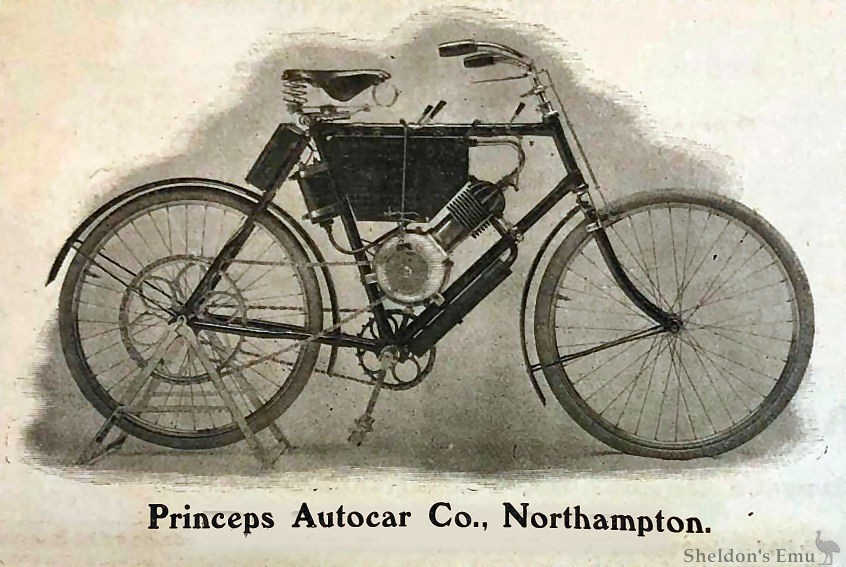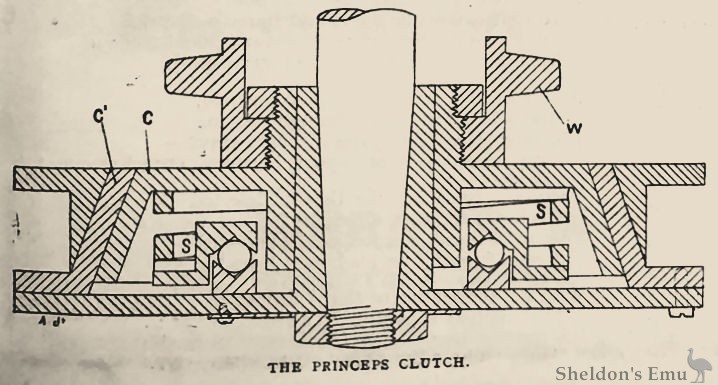



The Princeps motor-bicycle, made by the Princeps Autocar Co., Northampton, is a machine possessing many distinctive features in its construction and, moreover, one that is symmetrical and compact in its design and of moderate weight. The special features are the chain drive, clutch transmission, and a free engine at will.

The Motor, it will be observed, is placed in an inclined position inside the frame, and is very rigidly clamped by the crank case to the main and diagonal tubes; and there is also an extra clamp from the top of cylinder to main down tube. This system strengthens the frame and relieves any strain on the bracket joints. The power claimed for the motor is 1¾ h.p. Special radiators are fitted to the combustion chamber for offering the maximum cooling effect to it and the valves, and also to keep the heat as far as possible away from the rider. The crank case has no sharp corners, and presents a neat and smooth appearance. The silencer is an efficient double chamber type, and is seen fixed parallel to the down tube.
The transmission of power from motor to rear wheel is by a roller chain running on to a large diameter chain wheel screwed on to the hub. A carefully-designed cone friction clutch is interposed between the motor axle and small sprocket, and this counteracts any shock or strain being transmitted when the motor is running at a slow speed.
The illustration of the complete machine shows a lever passing down from the horizontal tube to the clutch. This is for throwing the clutch gradually into gear, and allowing a certain amount of slip when starting and full engagement when speed is attained. Another advantage is that a complete disengagement of the clutch allows engine to run free when coasting hills or in traffic, and also enables engine to be started before rider mounts if so desired. This is readily done by simply putting a turn or so of stout cord round the drum and giving it a smart pull. As the engine can be thrown out of gear, no exhaust lifter is necessary, but simply a compression tap, for starting.

The Princeps Clutch
Details of Clutch Mechanism.
The principle of the Princeps friction clutch will easily seen from the illustration. The female part of the clutch is secured to the engine shaft. The male part, carrying the chain wheel, is held in engagement by a spring, the base of which is seated on a ball bearing. Disengagement is effected by means of a lever operated by a handle on the top of the bicycle. The movement of this lever influences the full or partial engagement of the clutch, and a slip drive or a rigid drive is perfectly under the control of the rider. When the handle is pushed over to its furthest extent the engine is thrown out of gear and runs free.
Chain adjustment is effected by having a draw bolt attachment for motor drive and an eccentric bracket adjustment for the pedal drive, thus they are independent of each other. The electric system for the ignition is of the standard high tension coil and battery type with positive contact. The accumulator is of 20 ampere hours capacity, and is carried in a neat case clipped to the back forks ; it is thus easily accessible.
The coil is of a celebrated French make of circular form, and fixed to the diagonal tube. The ordinary pattern of switch handle is dispensed with, and instead the hand lever of front brake is so arranged as to open the circuit when brake is put on. This is effected by bringing the wire from negative pole of accumulator to an insulated contact piece clipped to the handlebar stem. The brake lever is, of course, in metallic contact with the frame, and when it is off the end of it presses up against a stud in contact with negative wire from accumulator, hence the current gets to the contact breaker case through the frame. A plug switch is also provided in the insulated contact piece for permanently breaking the circuit.
Brakes. - In addition to the front rim brake a Bowden rim brake is fitted to the back wheel and is actuated by a lever on right of handlebar.
The carburetter is a very efficient form of the surface type, but a spray carburetter can be fitted when desired. A good supply of petrol can be carried, and float indicator is provided.
Lubrication of the motor is effected by means of a small force pump. This is fitted in a small detachable reservoir fixed to the side of carburetter tank, and can be used whilst machine is running; The wheel base of machine is 46 inches, and the wheels are 26 inches diameter, and 2 inch Clipper or Dunlop tyres are fitted as standard.
An actual trial of the machine proved that it justifies the claims made for it. It goes up hills well, and for a chain driver it is very free from vibration. The speed can be regulated by the mixture and throttle valves and spark advancer.
Motor Cycling, August 13th 1902
The New Two-Cylinder Princeps Motor.
The principle of the 2¾ h.p. double cylinder bicycle motor, made by the Princeps Autocar Co., 46, Abington Street, Northampton, is that of two cylinders, mounted on one crank case, tandem-wise, inclined in such a manner that the drive is through one crank pin connecting one pair of fly wheels. The connecting rods are specially designed to effect this purpose without having to increase the width of the crank case. Each cylinder is 62 mm. bore and 70 mm. stroke, and is provided with compression tap and exhaust valve lifter. Both compression taps are actuated by one lever, and one lever also serves for both exhaust valve lifters. In the latter case a partial movement of the lever cuts out one cylinder for slow driving in traffic, and the completed movement cuts out both cylinders. The engine shaft takes either a toothed wheel for chain drive or a pulley for flat belt drive, as desired, and the now well known Princeps clutch can also be fitted to provide a free engine at will. The electric make and break contact is through double blades working alternately by means of a special double cam, the whole being contained in a case of the usual size. One carburetter supplies gas to both cylinders. This is a new pattern specially made by the company, which, after a first adjustment, acts automatically at any speed. It will be seen, therefore, that the use of the two cylinders causes no complications in driving, the same number of levers only being required as in the single cylinder type; and when the motor is placed quasi-vertically in the low type of frame, no more practical space is taken up either in height or width than when a single cylinder motor is fitted. Great smoothness of running and absence of vibration is secured by the motive force being exerted every revolution and the careful balancing of the fly wheels.
Motor Cycling Magazine, September 3rd 1902.
Kees Koster has supplied an image demonstrating that the 1902 Princeps is in fact a 1902 Bruneau